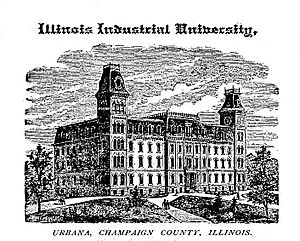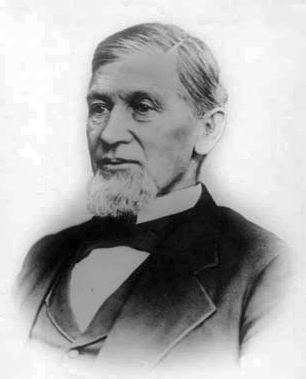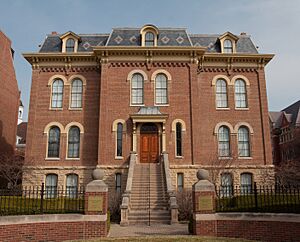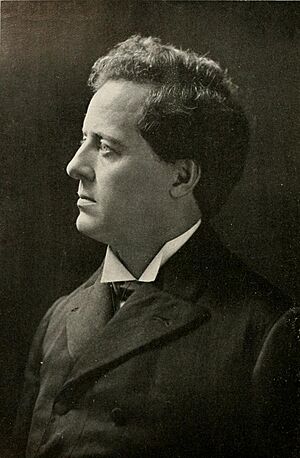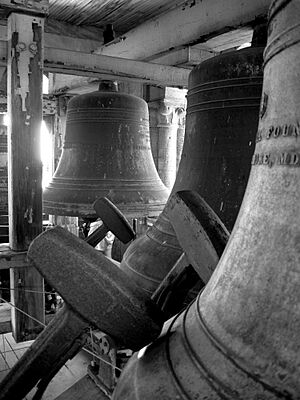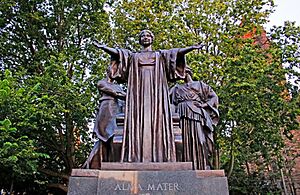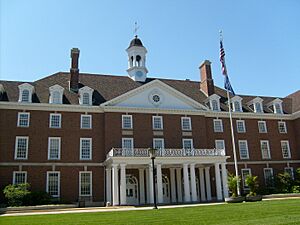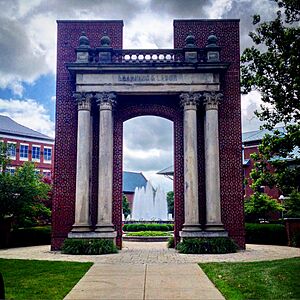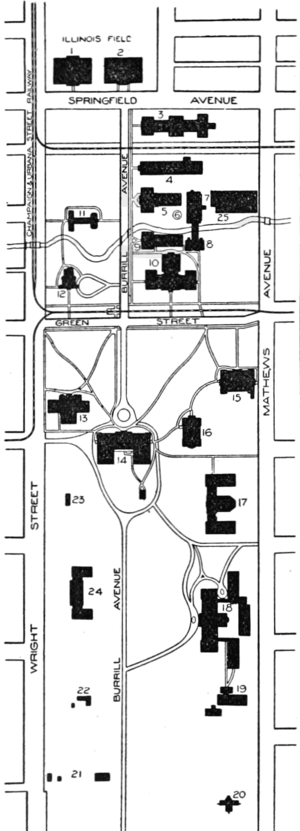History of the University of Illinois Urbana-Champaign facts for kids
The history of the University of Illinois Urbana-Champaign began in 1862. This university, often called U of I or Illinois, is a public research school in Illinois. It's a special kind of school called a land-grant university, which means it received land from the government to help teach practical subjects. It's the main campus of the University of Illinois system. The University of Illinois Urbana-Champaign first opened its doors on March 2, 1868. It's the second oldest public university in Illinois and helped start the Big Ten Conference.
Contents
How the University Began
The university was created as one of 37 public land-grant schools. This happened after the Morrill Land-Grant Colleges Act was signed by President Abraham Lincoln on July 2, 1862. This law gave each state land to build a big public university. These schools were meant to teach farming, mechanical skills, and military training. They could also teach other science and classic subjects.
This idea of teaching "other scientific and classical studies" caused some arguments. Many people in Illinois wanted the university to focus only on "industrial education," which meant practical skills. But the university's first president, John Milton Gregory, wanted to include a wider range of subjects, like the liberal arts. This disagreement caused problems for Gregory during his time as president.
In 1867, Illinois decided to build this university to help working people get a higher education. After different cities competed, Urbana was chosen as the location in 1867. The university opened on March 2, 1868, with just two teachers and 77 students. In that first year, the College of Agriculture and the College of Fine and Applied Arts were started. The College of Engineering followed in 1868.
President Gregory believed in a broad education, but many state leaders wanted a focus on practical skills. This debate continued throughout Gregory's 13 years as president. He eventually resigned in 1880 because of the heavy workload and constant disagreements. However, many people believe Gregory is the reason the university is what it is today. His grave is on the Urbana campus, and his headstone says, "If you seek his monument, look about you."
The university's Library opened in 1868 with over 1,000 books. It grew slowly at first. Later, President Edmund J. James had a big vision for the library. In 1912, he suggested building a new library to hold "at least a million books." Today, the University Library system is one of the largest in the country.
In 1870, the Mumford House was built as a model farmhouse for the school's experimental farm. It is still the oldest building on campus. The main University Hall was built in 1871. It stood where the Illini Union is today. In 1877, Harker Hall was built as the Chemical Laboratory. It was later named after Oliver A. Harker, who was dean of the law school. During this time, student groups also started, like the campus newspaper, The Daily Illini, which began in 1871.
How the University's Name Changed
| University names | |
|---|---|
|
|
Name |
|
|
|
| 1867 | Illinois Industrial University |
| 1885 | University of Illinois |
| 1935 | University of Illinois at Urbana-Champaign |
| 2020 | University of Illinois Urbana-Champaign |
| *Official name change where "Urbana" & "Champaign" were used in publications previously | |
When it first started in 1867, the university was called "Illinois Industrial University." In 1885, its name officially changed to the University of Illinois. This new name showed that the school now taught farming, mechanical skills, and liberal arts. This name lasted for 50 years.
In 1935, the name changed again to the University of Illinois at Urbana-Champaign. Later, the "at" was dropped. Even today, many people still call it "the University of Illinois" or just "Illinois." Since 2008, the university has been using "Illinois" more often, even changing its website and email addresses to end with "Illinois.edu."
Growing and Expanding the Campus
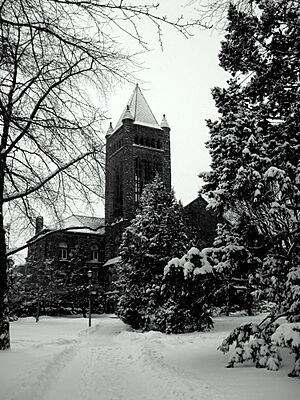
In 1882, the College of Medicine was created. The university faced money problems in the 1880s. This was part of the reason for the name change in 1885, to avoid confusion with other types of schools.
After a long search for a new president, Andrew S. Draper was chosen. He helped the university offer more subjects, adding schools for law, library science, and medicine. In 1884, Carlos Montezuma, a Native American student, graduated from the university. He is believed to be the first Native American to earn a medical degree from an American university.
Around 1889, more students joined, and more courses and departments were added. The university became known for its research in farming and engineering. In 1893, the School of Library and Information Science was established. This was followed by the College of Applied Health Sciences (1895) and the College of Law (1897). Also, Altgeld Hall was built starting in 1896. It was designed by Nathan Ricker and James McLaren White from the university's architecture department. This building was originally the University Library.
In 1899, Dean Eugene Davenport helped the College of Agriculture get more funding. This led to the creation of more colleges.
Edmund J. James became president in 1904. During his time, the College of Education (1905), College of Liberal Arts and Sciences (1913), and the College of Business (1915) were all started. President James also helped bring many Chinese international students to campus. He worked with the Chinese Minister to the United States to create a direct link between China and the university. He even set up the first office for foreign students in the United States. Between 1911 and 1920, about one-third of all Chinese students in the U.S. were studying at the University of Illinois. Some of these students later became important leaders in China. The Altgeld Chimes were put in the University Library's tower (Altgeld Hall) in 1920.
After James, David Kinley was president from 1920 to 1930. During this time, the university became known for its many student clubs and groups called fraternities and sororities. The College of Media was also established in 1927. On June 11, 1929, the Alma Mater statue was revealed. This statue was paid for by donations from alumni and student classes. It was moved to its current spot in 1962.
Presidents Harry Woodburn Chase (1930-1933) and Arthur Hill Daniels (1933-1934) followed. During Chase's time, the School of Social Work was created in 1931. Like many universities, the Great Depression slowed down building and growth during President Arthur C. Willard's term (1934-1946). Even so, the old University Hall started to fall apart in 1938. The university replaced it with Gregory Hall and the Illini Union. Parts of the original University Hall were later used in the Hallene Gateway. The Illini Union was the first building made just for student social activities and services.
After World War II
After World War II, under President David Henry, the university grew very quickly. The number of students doubled, and the school's academic reputation improved. This period also saw the creation of Willard Airport. It was finished in 1945 and started service in 1954. The airport is named after former University of Illinois president Arthur Cutts Willard.
During these years, the university also saw a big increase in graduate students and more government support for science and technology research. There were also some fun traditions, like the "water fights" or "water riots" that started in 1957 and continued into the early 1960s.
The 1970s brought many new programs to help different student groups. The Afro-American Studies Commission was created in 1970, and the university offered its first Women's Studies course that same year. The Office of Minority Student Affairs was formed in 1974, and La Casa Cultural Latina was founded in 1970. The first official Quad Day, a tradition where student groups set up booths on the main quad, was held in 1971 and still happens today.
The campus became famous for its huge Earth Day 20 celebration in 1990. This three-day event was organized by students and became the largest Earth Day celebration in North America. Over 15,000 people attended, with speakers like Ralph Nader and several rock bands.
Late 20th Century Changes
| UNIVERSITY OF ILLINOIS, Urbana-Champaign | |
|---|---|
| College/school |
|
| Agriculture, Consumer, and Environmental Sciences |
|
| Fine and Applied Arts |
|
| Engineering (Grainger) |
|
| Medicine (University of Illinois) |
|
| Library and Information Science |
|
| Applied Health Sciences |
|
| Law |
|
| Education |
|
| Liberal Arts and Sciences |
|
| Business (Gies) |
|
| Media |
|
| Social Work |
|
| Aviation |
|
| Labor and Employment Relations |
|
| Veterinary Medicine |
|
| Medicine (Carle Illinois) |
|
In January 1998, President Bill Clinton visited the University of Illinois. A funny incident happened when Air Force One, the President's plane, got stuck in mud at the campus airport! A backup plane had to be sent to take President Clinton away.
On October 8, 1998, the Hallene Gateway Plaza was opened. This plaza was paid for by alumni Alan M. and Phyllis Welsh Hallene. It features the original stone entrance from the old Main University Hall. After the original building was taken down in the 1930s, these pieces were stored away. They were rediscovered in 1994 near some maintenance sheds.
The 21st Century
In the past, the state of Illinois provided most of the university's money. But in recent years, the state's support has decreased a lot. Now, most of the university's budget comes from other sources.
On September 12, 2014, discussions began about creating a new medical school at the university. This would be the first new college created in Urbana-Champaign in over 60 years. The new program would focus on how engineering, technology, and big data can be used in health care. The idea was to train "physician-scientists" who could work as doctors but also create new medical tools and ideas. The university's leaders approved this plan on March 12, 2015.
In 2015, the University of Illinois announced that its newest student housing building would be named after Carlos Montezuma, also known as Wassaja. He was the first Native American to graduate from the university and is believed to be one of the first Native Americans to earn a medical degree from an American university.
The Campus Today
The Main Quadrangle at the University of Illinois Urbana-Champaign is the heart of the campus. It's a large open area surrounded by buildings of the College of Liberal Arts and Sciences. It's a central spot for many campus activities.
Many important buildings on campus are listed on the National Register of Historic Places. These include the Mumford House, Main Library, Altgeld Hall, and Harker Hall. Also, the Morrow Plots, which are the oldest experimental crop fields in the Western Hemisphere, and the University of Illinois Observatory are special places called National Historic Landmarks.
See also
- WPGU – The student-run commercial radio station.
- List of University of Illinois Urbana-Champaign people – A list of famous people connected to the University of Illinois.


